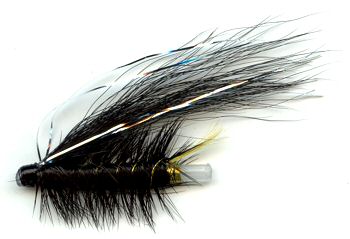The Stoats Tail 1 1/2 Inch Plastic Tube Fly
The Stoat’s Tail plastic tube fly is a simple but very effective creation. It has accounted for many salmon over the years.

SALTWATER, SALMON & STEELHEAD TUBE FLY
$US each. Price does not include hooks.
The North American steelhead Black Bear fly has more than a passing resemblance to the Stoat's tail. It is a good bet when the fish refuse the more gaudy patterns and during times of low water disinterested fish. There is debate over it's origins. In "Trout and Salmon Flies" by Sutherland and Chance it is listed as originating at Park on the river Dee in Scotland. In the "Encyclopedia of Fly Fishing" by Conrad Voss Bark the Stoats tail is credited to James Wright of Sprouston-on-Tweed (Scotland) made during 1870-80's . Nowadays it is given a dyed bucktail or black squirrel wing. The salmon do not appear to notice the difference as it is still a very productive salmon fly. This black fly can be irresistible to salmon, Steelhead and sea trout in difficult summer conditions of high water temperature and low levels. It is also very popular in big clear water rivers. This fly will take both 'stale' and 'fresh' fish in all hook sizes and weather conditions. It is a good all-round fly.
I love the exhilarating site of a salmon attacking my fly on the water surface which precedes the unmistakable pull on the line. It is such an adrenalin rush. For Salmon to take on the surface depends on a number of conditions like water height, clarity, freshness of salmon in the pool, and that the air temperature is warmer than the water’s. Newly arrived sea run salmon are going to be more active and eager than long term residents. This is particularly true for countries that are nearer to the Atlantic Salmon’s sea fishing grounds, like Russia, northern Scandinavia, Canada and Iceland.
Surface fishing salmon flies on the American east coast, the British Isles and northern mainland Europe can also bring results. The added excitement of surface action makes them worth trying. I normally use this technique during periods of low water. You have to be particularly careful on how you approach the water so as not to spook the fish. If the salmon spot your arrival there attention will be on you and not your fly.
I do not try surface salmon fly fishing on bright sunny days. Overcast days are best. Just like you fish do not like to look directly into the sun. It hurts their eyes, so they scan the depths not the surface for their next meal or potential threat. Some seek shady locations as a respite from the glare of the sun. These are good locations to seek out salmon on bright summer days. The other alternative is to get up early before the sun is high in the sky or fish late in the evening when the sun has gone down behind a hill.
There are two favoured modern salmon dry fly fishing methods. The first is the drag free dead drift, where the fly is floated over the top of salmon without any movement except that caused by the water current. The other is called skating. This is where the fly is retrieved over the water surface to cause a wake that I designed to attract the attention of nearby salmon.
The most popular salmon fly to use as a dead drift surface fly is the clipped deer hair cigar shaped Bomber fly. It is cast up stream out of the salmon’s field of vision and then allowed to drift with the current. The fly is allowed to drift past the salmon out of its sight before being retrieved so as not to spook it. Dry fly fishing for salmon is not new. The Victorians were practicing the art over 150 years ago in Scotland. Other modern dry flies that are used to catch salmon are big Gray Wulff, Adam’s Irresistible and the Royal Wulff.
The skating method is also known as Dibbling. It can be a productive technique on turbulent rivers and is very similar to how you fish a caddis dry fly. Skating a tube fly across the water surface in a controlled manor to produce a wake can produce some exciting rises. It is thrilling to see a dark shape following your fly but frustrating when you see it turn away. Adjust the speed, direction and pause of your retrieve until you get it just right to excite a salmon to attack. You are imitating a juvenile fish hunting near the surface for food. They do this in a darting movement. I find a long rod is best to be able to precisely control the tube fly
The Stoat’s Tail 1 ½ plastic tube fly is a simple but very effective creation. It has accounted for many salmon over the years. Its large mobile light body is big enough to cause a wake that salmon find attractive. Even though they may not be feeding, their aggressive instinct makes them investigate any nearby disturbance. They home in on the source and if they are in the mood, attack with aggression.

